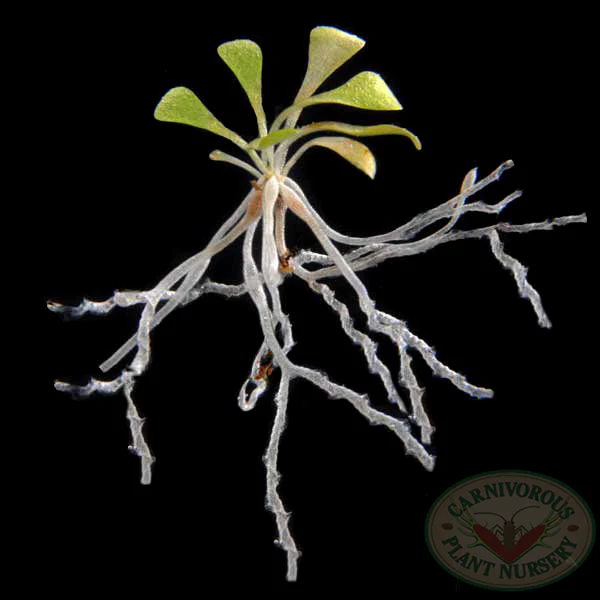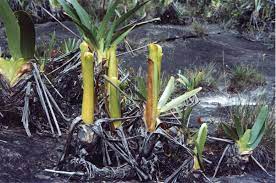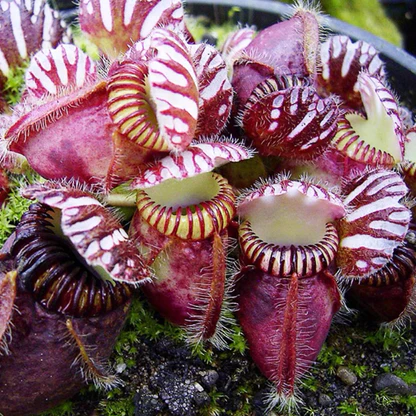Plants that Prey: Carnivore Basics
- Oct 9, 2023
- 10 min read
From childhood curiosity to lifelong obsession, Carnivorous Plants provide endless fascination, variety, and maybe a little pest control along the way!
Dwelling in poor soils--or in some cases without soil at all--carnivorous plants supplement their need for nitrogen and other nutrients by trapping insects and other small creatures which they digest before absorbing their nutrients.

Venus Flytrap (Dionaea muscipula)
For almost everyone, the "gateway" carnivorous plant is the Venus Flytrap. Though exotic-looking, these unique plants are actually native to only one small location in the American South: the southernmost coast of North Carolina. Specifically, they occur within the area defined by an ancient meteor crater that lies around and just south of Wilmington, NC. At one time, their range extended just across the border into Horry County, SC, but they appear to have long-since become extinct there. In fact, if it weren't for strict laws to protect them, Venus Flytraps might easily have been extirpated from the wild in North Carolina, as well, due to the once-booming trade in plants scavenged from the wild. As it stands now, the state carefully protects their wild locations and actively prosecutes anyone attempting to steal them from their native habitat. Growing low to the ground in moss hammocks, swamps, and pocossins, Venus Flytraps enjoy bright, full or near-full sun and sandy, marshy soil that drains quickly but never dries entirely. The plants we (and all reputable sellers) offer are grown from tissue culture in labs, producing healthy specimens at low cost without depleting the already threatened native populations. To grow Flytraps successfully, plant them in a mixture of clean sand and long-fiber sphagnum moss, keep them in full sun, preferably outdoors when possible, and keep the bottom inch or so of their pots saturated with water at all times. Like all carnivores, VFTs are very sensitive to chemicals in their water and should be provided either rainwater or distilled water in the home setting. And like all insect-eating plants, they should never be given any sort of commercial fertilizer or potted in ordinary soil. There are many cultivars of Venus Flytrap, though they all represent the same single species. In recent years, breeding by collectors has produced plants with giant traps,
tiny traps, bright-red coloration, and many more variations. Flytraps produce a sweet-scented nectar that attracts a variety of flying and crawling insects. Inside the hinged clamshell-shaped leaf are six short, stiff trigger hairs, three on each half. An insect must either stimulate multiple hairs or the same hair repeatedly in order to spring the trap. Once this happens, an electrical impulse triggers expansion of cells in the lower part of each leaf half via a sudden influx of water, causing the trap to snap shut in the blink of an eye. Once trapped, the insect prey is flooded with digestive secretions produced by specialized cells inside the leaf, which quickly begin to break down the proteins in the insect's body for absorption by the plant. After digestion is complete (typically in 1-3 days), the trap will open and "reset", ready for its next victim. Of course, all this complex activity is taxing, and the leaves have a limited number of trapping cycles before starting to die and decay, to be replaced by new ones.

Purple Pitcher Plant (Sarracenia purpurea)
Another carnivore uniquely native to North America, the American Pitcher Plants (genus Sarracenia) use a completely different strategy for catching prey. Their tubular leaves variously grow near the ground or held high in the air, depending on species, and exude a sweet nectar that has a magnetic attraction for insects. When a hungry bug lands on the leaf, it encounters a patch of stiff bristles, pointing toward the depths of the trap. Unable to move backward against this wall of rigid spikes, the insect is forced to advance further and quickly finds that its footing becoming quite slipperly, thanks to a layer of wax secreted by the leaf. Struggling to maintain its grip, the hapless creature soon tumbles into the abyss, landing in a pool of rainwater and digestive juices that immediately begin to break apart the bonds of its protein-rich body, ending in death for the insect and lunch for the plant. Because these plants don't have to move a vegetable "muscle" to ensnare their meals, they are referred to as "passive traps." For the collector, American Pitcher Plants present a wide variety of leaf shapes and sizes, as well as arguably the most beautiful flowers among meat-eating plants. The large, showy blossoms hang at the end of tall stems intended to keep them away from the actual traps (after all, it's hard to get pollinated if you're always eating your visitors!) Like the Venus Flytrap, American Pitcher Plants are found mostly in bogs and marshes, where the soil is lacking in the needed nutrients plants need to thrive. As a result, they have the amazing capacity to take advantage of other, slightly more macabre, means of getting their nutritional needs met! We grow American Pitcher Plants in a 50/50 mix of Sphagnum peat moss and coarse sand or perlite, let in containers where the bottom inch or so of their pots are always in water. They love bright, full sun, and thrive outdoors here in North Carolina during warm weather. Depending on the species and its origins, some of these remarkable plants live just fine through the relatively cool winters in our Blue Ridge Mountains at an elevation of about 1,400 feet above sea level. (Species like the Purple Pitcher Plant (Sarracenia purpurea) and a few others are found all the way up the East Coast of the U.S. and into Labrador in Canada, while others are limited to the Gulf Coast or Deep South, where winter temps aren't as cold as they are here in the mountains.) Like all carnivores, they should be kept away from any commercial fertilizer and never be potted in ordinary soil. As with most other bog plants, they prefer a slightly acid soil pH, as well.

Cape Sundew (Drosera capensis)
A third mechanism plants use to trap insect prey is the "flypaper" trap, and the carnivorous Sundews are a prime example of this technique. Found across many regions of the United States as well as in Europe, Africa, and Australia, Sundews' leaves sport tiny tentacles, each of which exudes a drop of dewey, sticky muscilage, ready to ensnare whatever crawling or flying visitors may be attracted by the plant's copious nectar. Depending on the species, the insects may simply become stuck, or the leaf may actively curl around them in slow-motion, making their doom even more certain and increasing their exposure to digestive juices that flow from glands in the leaf. When the prey is dissolved and absorbed, its now dry, hollow carcass is carried away by the wind, leaving room for another "guest." By and large, Sundews are tiny gems, rarely growing very large, though a few species can become up to a foot or more tall and many have a clumping habit, forming mats of insect-munching foliage. Because of their wide variety and distribution, care for Sundews varies by variety, with some going into winter dormancy, some tolerating much more cold than other, tropical species, etc. We offer full care instructions with every plant and are always happy to talk with you about the best way to get your next new purchase to thrive and delight you!

Butterwort (Pinguicula)
Building on the theme of "flypaper" traps is the lovely and unassuming Butterwort, another widely-distributed carnivorous plant that uses sticky leaves to trap small prey for the plant to digest. These miniature beauties also share something in common with American Pitcher Plants, though they're not closely related: both are grown as much or more for their beautiful flowers than for their lethal foliage. In the case of Butterworts, the flowers are seasonal, held above the leaves on thin stalks, and colored in brilliant pastel hues. Leaves. of the Butterwort grow in a flat rosette, hugging the ground, where they attract not only flying insects, but many crawling ones, too. Glands on each leave secrete a sticky glue that traps their visitors feet as soon as they land, and the prey's movement stimulates the plant to secrete more and more sticky goop, miring the insect and beginning the digestion process. In most species, the leaf's margins begin to fold inward in respond to struggling prey, allowing the digestive juices to pool and more efficiently liquify the victim. Most Butterworts trap lots of tiny flying insects like gnats, Whiteflies, midges and the like. Like their distant cousins the Sundews, Butterworts are found in a wide range of habitats and locations, so there is very little to offer in the way of general cultural advice, but we do provide specific care instructions with each plant we sell and are happy to consult with you at any time about how to help your plant best grow and thrive. The leaves of European Butterworts have long been used to clot milk, and Steve has been blessed to see these tiny beauties by the hundreds, growing on mossy stone walls along mountain paths in Switzerland.

Sun Pitcher Plant (Heliamphora)
In the high mountain plateaus of South America dwells one of the least-known families of carnivorous plants, the so-called Sun Pitchers, genus Heliamphora. These amazing plants live in marshes and water seepages on flat mountaintop plains called tepuis, where the topsoil layer is often quite thin due to runoff from frequent rains. Like the American Pitcher Plants, these amazing creations use a funnel-shaped leaf to catch and digest insect prey. Though little-known until very recent decades, 28 species of Heliamphora have now been described, all variations of the same basic form. While many collectors consider them relatively easy plants once their specific condition needs are met, these are usually considered subjects for the more advanced grower experienced with carnivorous plants, since they need high humidity with frequent misting, bright light, cool soil temperatures, and a few other specifics that set them apart from the cultural methods common to many carnivores. Grow lights and a system for boosting humidity are essentials for healthy growth of Sun Pitchers indoors.

Cobra Lily (Darlingtonia californica)
Represented by a single species found only along the Pacific coastline of Northern California and Oregon, the Cobra Lily (genus Darlingtonia) is aptly named for sure! The tall, twisted leaves are a variation on the funnel-trap theme, with large inflated "hoods" reminiscent of a cobra in full defensive posture, complete with a forked "tongue" just below the hidden mouth of each pitcher. Atracted by the scent of nectar, insects land on the "tongue" and crawl upward toward the "mouth", guided by its twisting sprial. Once inside, the insect may realize it's trapped but by this time, escape is highly unlikely. The inner lip of the "mouth" curves inward like a funnel trap, guiding the visitor toward a slippery wax-coated interior hovering over a pit of digestive juices filled with the corpses of previous victims. While flying visitors might be tempted to make an escape by air, the wily plant has that base covered, too: the inflated "hood" is full of translucent window-like structures that allow sunlight to pass through, giving the impression of an escape route. When the insect tries to fly into one, however, it simply bounces off and lands in the fatal stew below. Cobra Lillies are famously challenging to grow in captivity, owing to their need for cool, flowing water at the root level year-round. Their native habitat enjoys a cool-temperate climate but not extreme cold in winter, thanks to the warming currents of the Pacific. Cool fog is a consistent part of this habitat, as well, and these plants need this cool, moist environment to grow well. Human ingenuity being what it is, however, many collectors have constructed setups to mimic the Cobra Lily's natural habitat, and a well-grown specimen is truly striking!

Tropical Pitcher Plant (Nepenthes)
Now we come to the true "royalty" among carnivorous plants, the Tropical Pitcher Plants of the genus Nepenthes. Though they look much like vining versions of the American Pitcher Plants, the two groups are not closely related. They do share a similar trapping mechanism, however, with a nectar-lined rim and lid, leading past a rank of inward-pointing stiff spikes and into a slippery, wax-coated "pitcher" filled with digestive juices ready to dissolve visitors in response to their first misplaced step. Hailing from tropical regions of the Old Word in places like Indonesia, Australia, and the Philippines, to Madagascar, India, and Sri Lanka. By far their greatest concentration is found in Borneo and Sumatra, where new species are still being discovered occasionally. In addition, the wide variety of shapes, sizes and colors of these amazing plants has led collectors to breed and reproduce a wide array of hybrids, each with distinctive characteristics. As you might imagine from their geographic distribution, Nepenthes (or "Neps", as they're affectionately called) enjoy temperatures mostly on the warm side, though the exact range for each species varies somewhat based on the altitude it calls home. Most Nepenthes grow as forest-floor plants and have a vining/scrambling habit called a liana, their vines ascending the trunks of trees, rocks, and other surfaces and finding footholds in the bark and moss to support the plant's often large and weighty fluid-filled pitchers. As a result of this habitat, the majority of Nepenthes prefer humid conditions with filtered sunlight or bright shade. Some modern hybrids are pretty adaptable, though, and most varieties can grow quite happily in a warm spot out of direct sun, provided with a humidity tray or regular misting. Though like their other carnivorous colleagues, Nepenthes mostly trap insects, there are well-documented cases of the larger ones trapping frogs, mice, birds, and occasionally even baby primates. Since the plant can't efficiently digest such prey, trapping a vertebrate usually results in rot and loss of the pitcher trap, so these appear to be accidental, not intentional victims. We grow hundreds of varieties of Nepenthes at Specialty Tropicals (they were our very first product line!), all in a 50/50 mixture of high quality long-fiber Sphagnum moss and coarse perlite, sometimes with the addition of some chunky orchid bark. Other growers report great success with media like coco fiber (coir), but the main rule is that these plants need consistent moisture but also a fast-draining soil that allows lots of air circulation around their roots, never letting them stand in saturated soil. Due to their tropical nature, Nepenthes need year-round minimum temperatures of at least 60 degrees Fahrenheit and often more, depending on the species or hybrid.

Trapping Mechanism of an Aquatic Bladderwort (Utricularia)
Bladderworts (genus Utricularia) represent yet another amazing trap style for carnivorous plants. In these plants, branching stems that extend into soil or water, depending on species, produce numerous small bladder- or purse-shaped traps, each with a trigger mechanism and a spring-loaded trap door to cover the opening. When an ususpecting prey item swims or crawls near, the trap is activated and sucks the prey into its own personal dungeon in lest than the blink of a eye, using a vacuum mechanism. Aquatic Bladderworts (which are common across much of the lowland American South in swamps and coastal regions) typically feed on lots of Water Fleas (Daphnia), while terrestrial ones (which come from tropical regions) tend to trap small roundworms like Nematodes. Most Bladderworts are fairly easy to grow, given the right conditions, and some have attractive flowers, as well.
Other Carnivorous Plants
Beyond the types we've already discussed, there are many more carnivorous plants, found in various parts of the world, and each with its own unique and amazing technique for luring and trapping insect prey. For detailed study, we highly recommend the excellent book by Peter D'Amato, The Savage Garden, which not only contains a wealth of information about carnivorous plants of all kinds, but also detailed care instructions and advice about which plants are suitable for everyone from the novice grower to the expert horticulturist.














Comments